POST
July 05 , 2022
Deciphering Street Eats in Istanbul
A guide to eating Turkish street fare like an Istanbullu.

What is it that makes Istanbul’s street food so special? These staples are an integral part of the comings and goings of daily life in the city – it’s no wonder why when you see how thriving and colorful the street atmosphere is. The contents of shops are proudly arranged in brimming sidewalk displays, outdoor diners take in either Bosphorus or old city views, groups of old men sip tea on tiny stools, buskers entertain a hubbub of visitors and commuters, and passersby stoop to pet the beloved cats of Istanbul, who own the streets. From early morning to late at night, there is a regular stream of busy - and hungry - people going about their day.
Thus the historic cuisine of Turkey finds an outlet in its street vendors, who offer up authentic tastes perfected by the specialization and repetition of their trade. The dishes echo the centuries and empires of Turkish rule (Roman, Byzantine and Ottoman). The food culture is indeed rich, but sometimes the simplest creations are the best – like fresh, flaky fish nestled in a warm and chewy bread bun.
Most of these street offerings are no-brainers, but foreigners to the Istanbul scene may have questions about what to order, how to order it, and how to eat it. We have rounded up the most popular street foods - from the humble and ever-present simit to more adventurous forms of nourishment. You’re gonna want to come hungry.
Simit
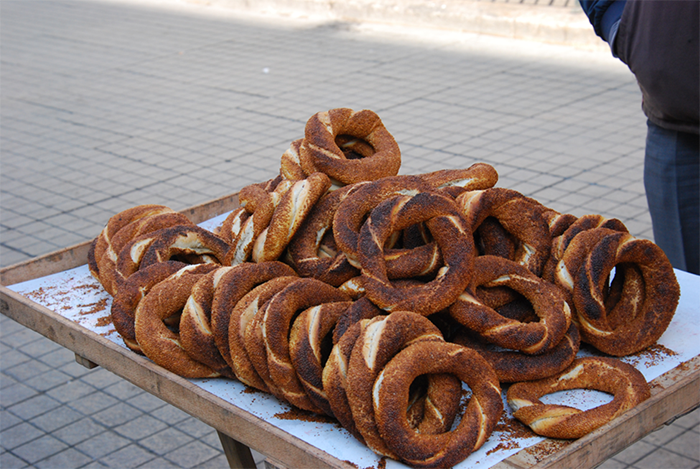
What is it?
Simit is one of those foods that unites the masses. From kids to adults, rich to poor, at any time of day, everyone eats these crusty, chewy bread rings. Dating back to Ottoman times, this donut-shaped snack should come soft on the inside and crunchy on the outside, thanks to its bath in molasses before baking, and a liberal coating of sesame seeds.
Where can I find it?
You will easily find simit everywhere! – on street carts and in bakeries, served alongside breakfast in restaurants, sold on ferries and at bus stops, hawked from the middle of crowded traffic lanes, and perched on the head of some sellers. It’s difficult to pass up the stacks of warm, inviting simit.
How should I eat it?
These treats require no add-ons, but it is common to enjoy one with a glass of tea. You can also add soft cheese (which you may be able to get from the street vendor), jam, or if you’re enjoying these for breakfast in a restaurant, they pair so well with Turkish honey and milk cream (bal kaymak). Just remember that they’re best enjoyed fresh on the day of purchasing. But don’t worry, you’re never far from fresh simit.
Kestane
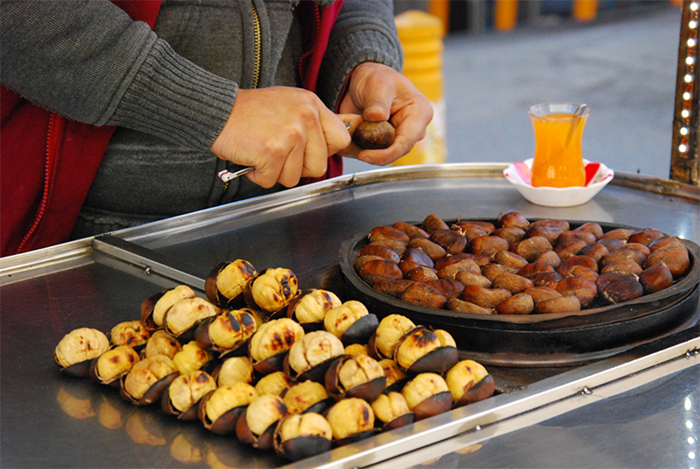
What is it?
Roasted chestnuts.
Where can I find it?
These plump bursting goodies can generally be found on any main street. The vendor scores and roasts them right on the traveling cart, so you can smell the pungent smoke as you come close.
How should I eat it?
Order them in a bag by the kilo, peel the outer husk away, and munch happily as you continue on your way. In contrast to other tree nuts and edible nuts, chestnuts are high in carbohydrate starch and low in fat and protein. They have a soft, not crunchy texture, and a slightly sweet and earthy taste that might remind you of the holidays.
Süt Mısır

What is it?
Another very simple street fare, corn-on-the-cob is a popular staple of Istanbul’s busy avenues. Translated as ‘milk corn’, süt mısır can be found boiled plain or grilled with spices.
Where can I find it?
In the summer, you can find this quintessential street snack all over the city. In other seasons these carts are more concentrated in areas visited by foreigners, such as Sultanahmet, Taksim, and Eminönü.
How should I eat it?
You can ask for more salt or spice if you wish, but in general just take two hands and dig in.
Fruit Juice Stands
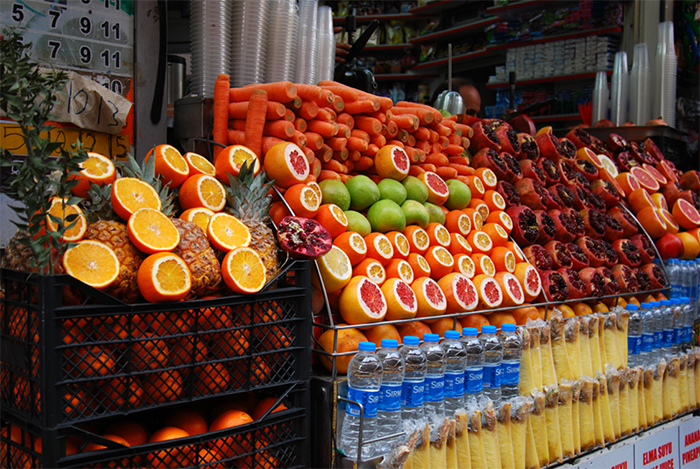
What is it?
You may know about Turkish tea (çay), but did you know there’s another beverage in town? One street drink definitely worth mentioning is the fresh fruit juice stands.
Where can I find it?
You can find the Vitamin juice stands on all the popular walking streets.
How should I eat it?
Enjoy your fruit juice by asking the vendor to combine any fruits or veggies you see on display. Pomegranate is very popular in Turkey, and really it’s hard to resist all of the brightly colored fruits calling to you, especially on a warm sunny day.
Pilav
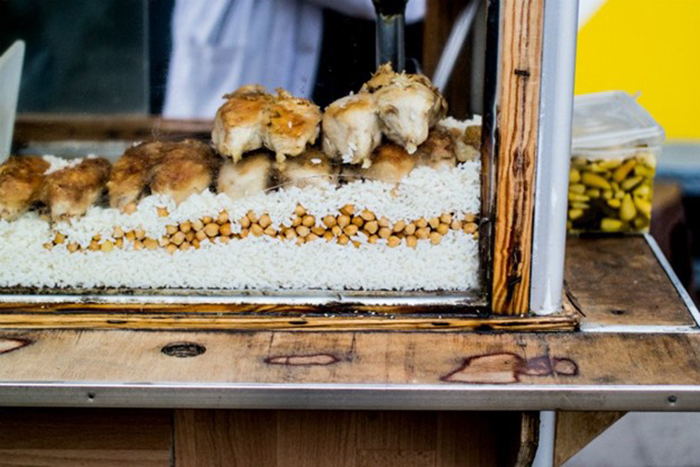
What is it?
Rice is an essential grain to the Turkish diet, and they really know how to use it. Another classic and simple meal you can find served from street carts is pilav (the grain cooked in tasty broth). You will usually find rice and chickpeas (nohut) or rice and chicken on these mobile stations.
Where can I find it?
These tasty and filling rice take-aways can be ordered from street carts in many popular areas of the city. You will probably also come across a small shop (pilavcı) that sells the rice with various toppings, and maybe soup as well.
How should I eat it?
This really delicious meal is best enjoyed hot, and whether you enjoy it sitting or on-the-go, we advise you to try it as soon as you spot one of the roadside carts piled high with steaming rice. Don’t forget to drink ayran (similar to buttermilk) along with your pilav.
Balık ekmek
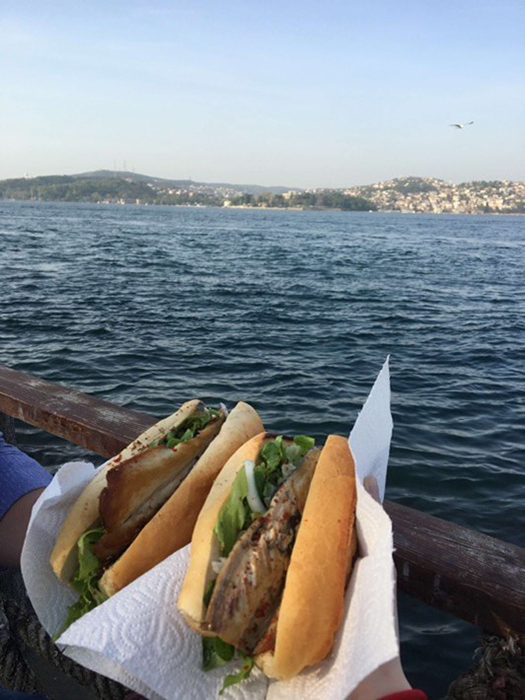
What is it?
Fish on a bread roll (balık ekmek) is an elementary meal for many Istanbullus. It is simply a sandwich of fresh fish on a soft bread bun, usually with lettuce, onion and a squeeze of lemon.
Where can I find it?
You can find these sandwiches in a restaurant, but why would you go there when you can get them in the street? Fish bread sellers are generally set up around any ferry station, but one prime spot for these grill masters is the row of fishing boats you will find in Sirkeci next to Galata Bridge.
How should I eat it?
What could be better than grilled fish fillet served in a handy bun with simple toppings? Have a seat alfresco on one of the small stools set up around the vendor, and perhaps enjoy a view over the Bosphorus while you dine.
Börek

What is it?
Many variations of this savory filled pastry can be found in the former lands of the Ottoman Empire. Turkey enjoys a wide variety of börek derivatives – whether it is cut into portions from a large pan of baked pastry, or served as individual filled pockets, or it comes in the shape of a rolled cigar, or puffy and deep fried. Traditional fillings for this dish include minced meat, salty white cheese, and potato, but one thing uniting the different börek versions is always the flaky phyllo dough (or yufka).
Where can I find it?
The options you will find in a sit-down börek bakery (börekci) will generally provide the best flaky experience. These places are readily available in all neighborhoods across the city. You will know you’re in the right place if you spot a guy swiftly cutting pastries with a large cleaver, or customers sitting over plates of flaky squares accompanied by dainty glasses of tea. But if you’re in a pinch while wandering the mesmerizing historical district of Sultanahmet, you’re sure to spot street carts laden with portable filled pastries. Go ahead and try it, you’ll only want more.
How should I eat it?
All börek is not equal, and there are multiple varieties to discover. On the filling side of things, minced meat (kıymalı) is a very popular option, worthy of its centuries of being in-demand. Cheese, potato, and spinach savories are also highly popular and may sit a bit lighter in the stomach than the meat. If you are ordering in a bakery you might also find more experimental fillings, such as eggplant or mushroom. Whether you eat it sitting, standing, walking, or on the metro with a fork (we have witnessed this but not recommended!), is up to you. Easily order by the portion (porsiyon) and there you have a meal prettily packaged for you in a buttery phyllo blanket!
Midye dolma

What is it?
What’s not to love about Istanbul’s seafood scene? First, we mentioned the glorious simplicity of catch-of-the-day fish plus bread, and now we have another famous street eat that is indebted to the sea. Stuffed mussels (midye dolma) are prepared with rice and seasonings (generally with cinnamon and currants) alongside the meaty mollusk.
Where can I find it?
While in Istanbul, you will likely visit İstiklal Avenue, the heart of Taksim and one of the main historic arteries of the city. Here you can always find mussel peddlers at-the-ready, with their tiny tables bearing piles of stuffed crustaceans and lemon wedges. These small bites are found in highly-trafficked areas of the city, as well as fish restaurants, for those less keen on eating mussels in the streets.
How should I eat it?
Stop by one of these moveable little snack stations to try one, two, five or more mussels for yourself. The beauty of the system is that you can order as many or as few as you want. Have a small snack as you refuel amidst shopping or sightseeing, or do as many local night-owls and enjoy these plump delicacies as a post-party fill up. The seller will open the mussel for you, squeeze lemon on top, and stick in one half of the shell for you to easily scoop out the contents.
Kumpir

What is it?
Kumpir is not your usual loaded baked potato. This spud seriously has everything. Among kumpir toppings you can find: cheese, olives, sweetcorn, cabbage slaw, pickles, sausage slices, mushrooms, carrots, peas, red beets, ketchup, mayonnaise, yogurt sauce, chili sauce, and more.
Where can I find it?
If kumpir sounds like your idea of a fun and customizable meal, then you can typically find it in any touristic area. We really suggest you head over to Ortaköy, a neighborhood tucked just under the Bosphorus Bridge on the European side, where you can find a row of kumpir vendors waiting to craft your potato just the way you like it.
How should I eat it?
These potatoes come huge, and on top of that you can load them with whatever toppings you desire. It will generally be given to you in a cardboard dish with a fork and it’s your job to make a dent in it.
Kokoreç

What is it?
Maybe for this one it’s better not to focus on what it is, but how it tastes. The most controversial of Turkey’s street foods, kokoreç is sheep intestines wound and cooked on a spit like döner kebab, then the chewy meat is chopped into smaller pieces and combined with a proprietary collection of spices before serving on a bread roll.
Where can I find it?
Not found on the street per say, but a casual and easy meal nonetheless, kokoreç shops are found in any neighborhood during all seasons.
How should I eat it?
The slowly grilled delicacy is mostly served in a sandwich and is another popular fare among the late-night crowd. Although you may have hesitations about trying this one, we assure you it’s a safe dish that many Turkish people have a great fondness for.
Çiğ köfte

What is it?
Again not strictly a street food, we want to make mention of çig köfte because it’s really unique, and also a good vegetarian option. Traditionally made with bulgur and spiced raw meat that was kneaded until it became cooked, today this street food contains only the grains and spices.
Where can I find it?
All neighborhoods in the city will have one or more çig köfte shops, and you will probably see someone in the window kneading this huge mixture by hand, while rows of lettuce and lemons wait patiently for their companions.
How should I eat it?
Enjoy this delicious soft morsel on top of a crispy lettuce leaf with a squeeze of lemon, and perhaps rolled up with parsley or mint as provided by the seller. You can also order it with a spicy chili sauce or have some tangy pomegranate syrup drizzled on top. For eating on-the-go, there’s the wrap version (dürüm).
Halka tatlısı
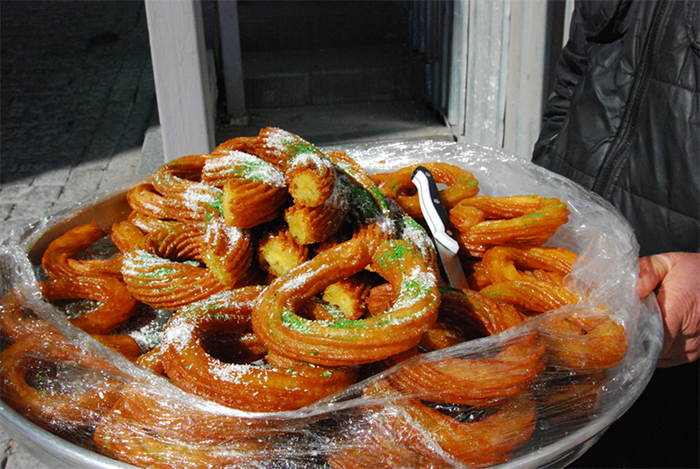
What is it?
Deep-fried Turkish churros soaked in a sweet syrup, dusted with powdered sugar and ground pistachios.
Where can I find it?
You can find these sweet desserts in any touristed area.
How should I eat it?
These circular crispy fried desserts are easily eaten in-hand, although things may get a bit sticky.
Kağıt helva
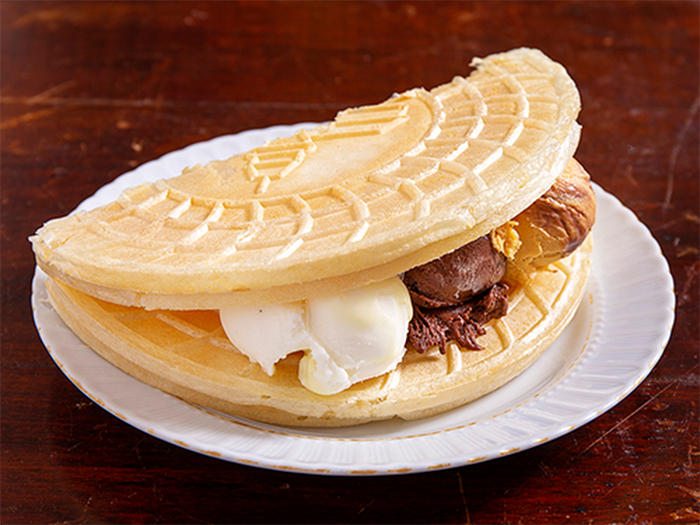
What is it?
For kids and big kids alike, Istanbul offers kağıt helva, translated as paper helva, or wafer. The best we can describe it is a thin, round waffle with a texture similar to that of a store-bought ice cream sugar cone.
Where can I find it?
You will mostly come across these from street peddlers selling the sweet wafers in transparent plastic bags. Taking a ferry commute or pleasure trip across the Bosphorus? You are sure to see these goodies sold, along with tea and simit, on board the vessel.
How should I eat it?
Children are big fans of these light, sweet snacks. There’s really no mystery to eating the discs, but if you’re feeling adventurous you could try your hand at making an ice cream sandwich with these.
Istanbul is a city of historical and culinary wonders to be sure. Here you will find no food carts selling the latest culinary fusion trend of the month, but a selection of time-tested dishes designed for convenience, portability, taste, and hunger satisfaction. We hope you now have a better understanding of what the locals are eating, and how you can enjoy it too!
If you want to try this special cuisine for yourself, check out one of our tailor-made itineraries like our 9-day ‘Tastes of Turkey’ trip especially for foodies – see it here.